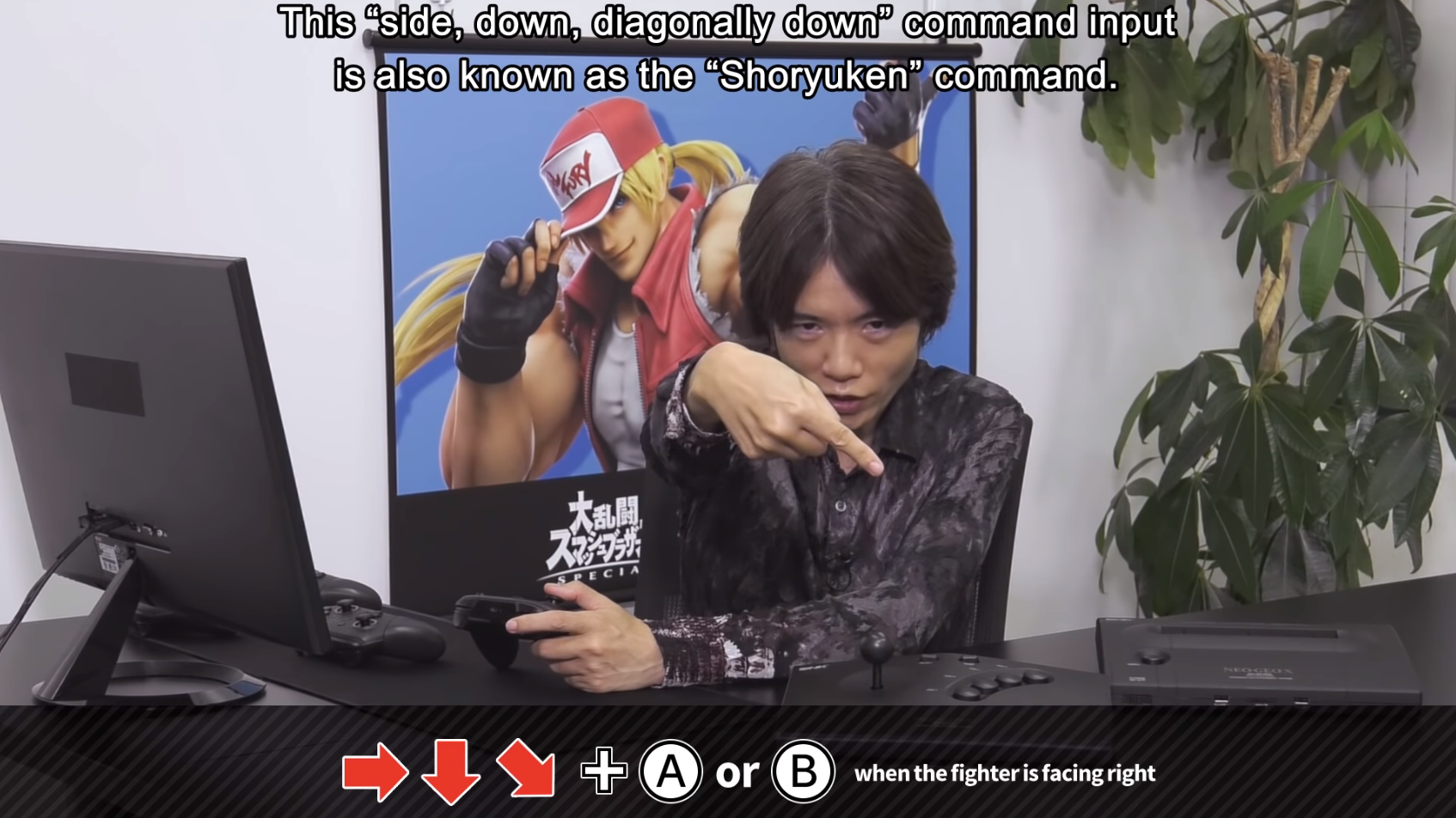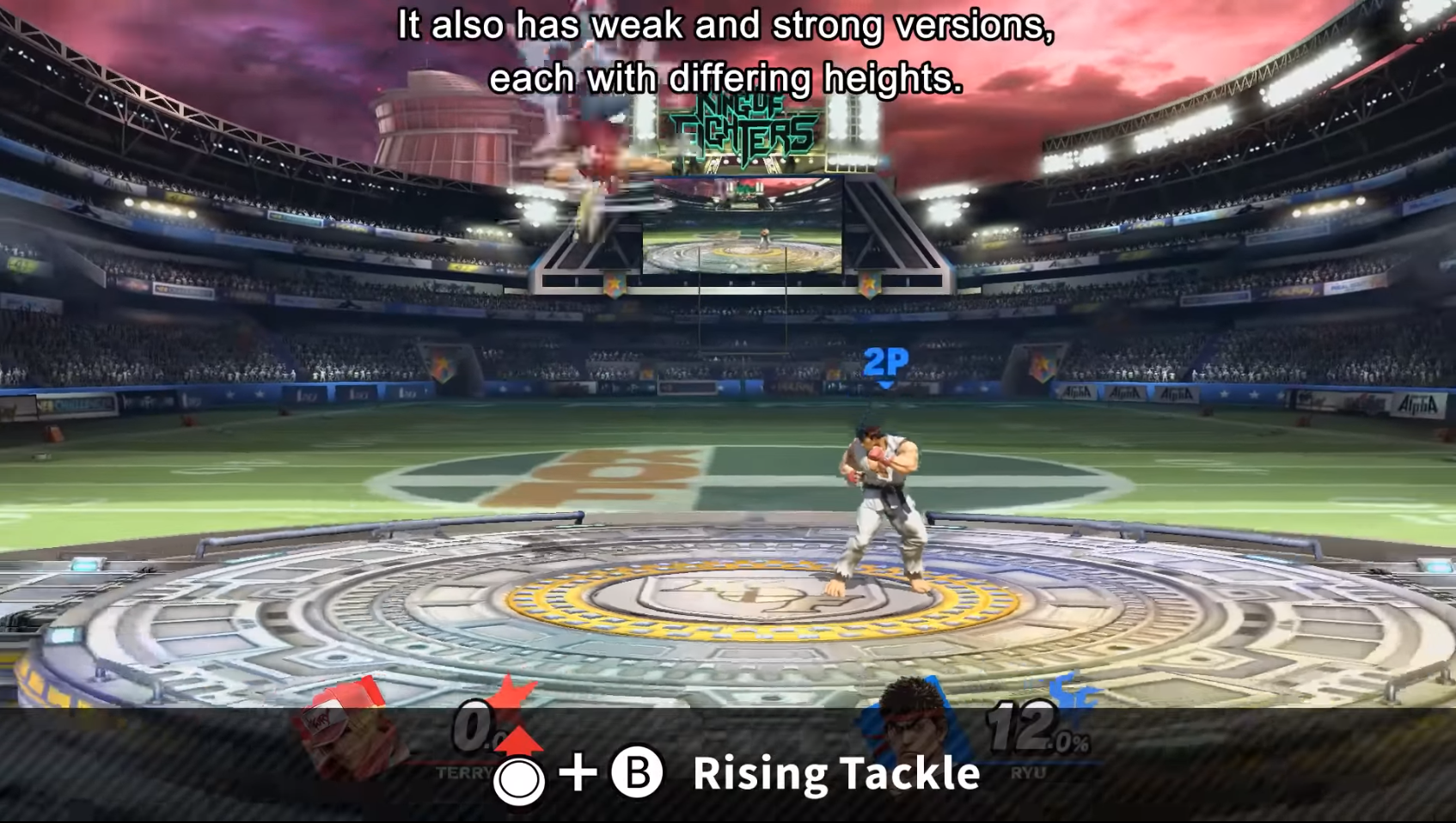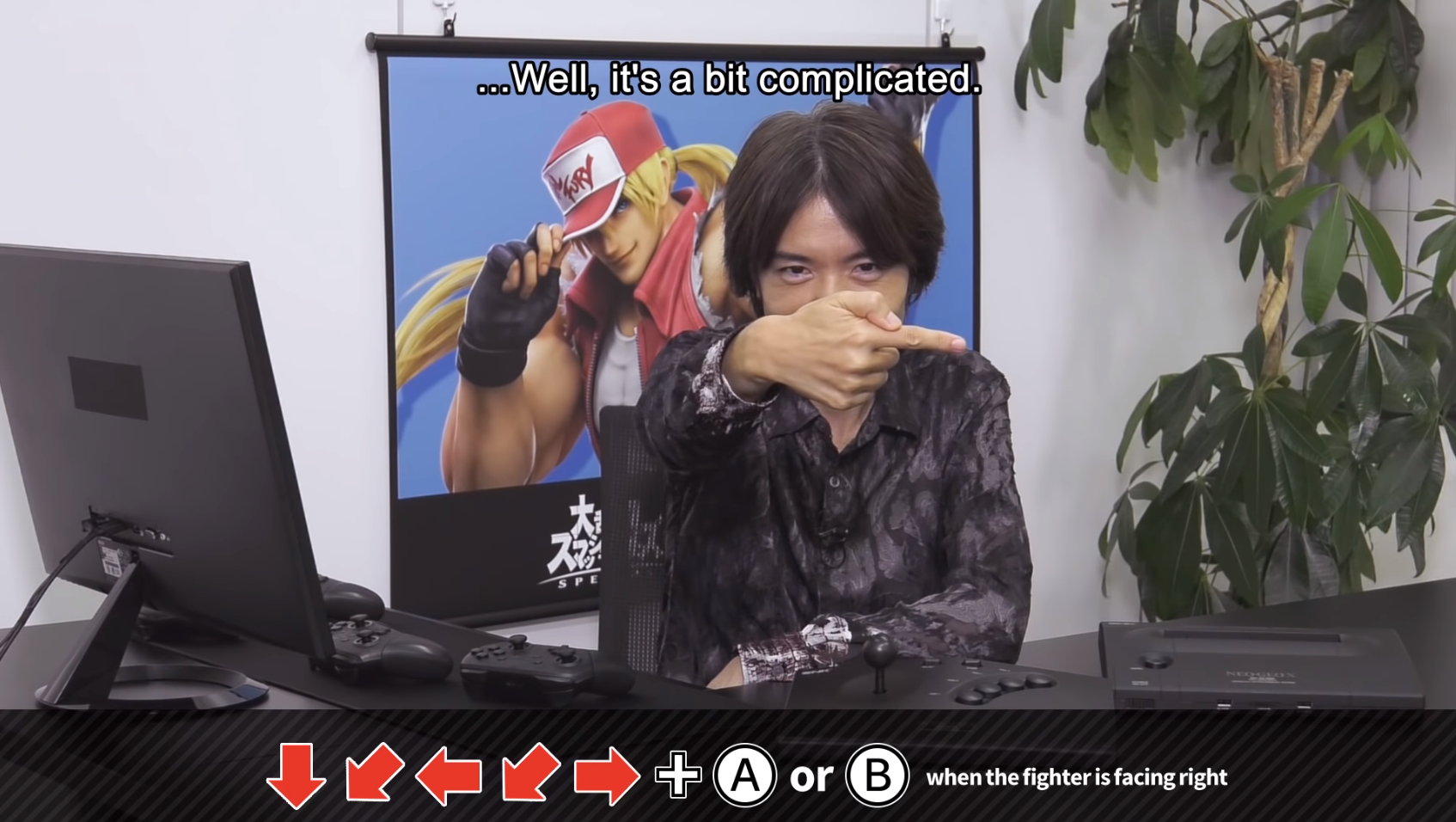
Terry Bogard from the Fatal Fury series is the latest DLC fighter to enter the fray in Super Smash Bros. Ultimate, and he might be one of the best characters in the game. Terry, much like his 2D fighting game counterparts Ryu and Ken, largely plays similarly, with a few key advantages. But really, it’s Terry’s suite of special moves and high strength that make him an option-rich character that opponents should be fearful of from all angles.
Given that Terry plays more like a traditional fighting games character -- even more than Ryu and Ken -- his bevvy of options makes him all that more complicated and difficult to master.
So, should you play as Terry? If you’re willing to put in the time to master him, then definitely yes. Terry is too complicated a character to keep as a secondary. He needs all your attention if you plan on playing with him competitively. And given that Smash is usually played on a GameCube or Nintendo Switch pro controller, pulling off his quarter-circle or shoryuken stick inputs (Z input) will only be that much more difficult in the heat of combat.
Basic moves
Terry’s major advantage comes with his special moves, and most of this guide will be dedicated to mastering those inputs. But his basic moves are important and will play heavily into his combo game with his specials.
The three button jab is pretty basic with Terry. Press the A button three times to do a one-two punch into a kick.
I’m personally a fan of Terry’s short-hop neutral. The easy way to do this is to press the jump button and the A button at the same time. I also like to then mash down on the stick to fast-fall. This lets Terry do a quick attack, fall back to the ground as quickly as possible, and then do another quick attack. It’s easy to rack up some damage and pushes your opponent to the side.
Terry’s forward-air (jump kick) and back-air (backward jump kick) are also great moves. His back-air is better than his forward-air though. I sometimes use his forward air after a string of neutral-airs that I mentioned in the paragraph above. Forget using Terry’s up-air (somersault kick) as it doesn’t do a lot of damage and has no real knockback. It’s better to use a special move when the opponent is above you.
Get instant access to breaking news, the hottest reviews, great deals and helpful tips.
Terry’s tilts are okay. His up-tilt (rising upper) is the best, as it has good range, and launches the opponent up at an angle that’s easy to hit. To execute, slightly tilt your stick up and press A. And his side tilt (middle kick) has good knockback. At low percentages, it sets Terry up for an easy dash attack as well. His down tilt (under kick) has low range and is largely forgettable.
So try this: Do a side-tilt, and as your opponent is flying off, run after them and do a dash attack.
Power charge, or Terry’s dash attack, is probably his most lethal basic move. It does 13% damage and can kill rather easily. For your combo game, try to work in power charge as much as possible.
Weak and strong specials
Every one of Terry’s special moves has a weak and a strong variation, as well as a command input variation. Let’s break this down in as easy-to-understand-terms as possible.
Terry’s neutral-B move is Power Wave. To pull this off, just press the B button. But, if you hold it down longer, Terry will launch a more powerful power wave, one that goes even faster. This concept of holding the input slightly longer applies to all of Terry’s special moves.
So yes, Terry’s up-b recovery move, rising tackle, can traverse two vertical distances depending on if you simply press the B button, or hold it down a little longer. This could make the difference between getting back on stage and not.
Okay, so that should be easy to keep in mind.
Quick press B = weak and shorter distance
Hold press B = strong and longer distance
Command Special: Burning Knuckle

But what makes things even more complicated for Terry is that all of his special moves have command inputs as well. What’s a command input? Well, in fighting games, it’s moving the stick in a certain direction before pressing a button.
For example, holding forward on your control stick and pressing B will release burning knuckle. Pretty simple, right? And just like its mentioned above, pressing or holding the B button will vary between weak and strong.
But if you do a down quarter-circle right, then Terry will release a more powerful burning knuckle. All you have to do is hold the stick down at six o’clock, and slide it all the way towards three o’clock and press B. But this too has weak and strong variations depending on if you press or hold the B button.
Quick press quarter-circle b = weak and shorter distance
Hold press quarter-circle b = strong and longer distance
So, if you break down Terry’s burning knuckle, it has four variations in total. That’s a lot of options to keep in mind.
But you’re probably wondering, why not just go with the strongest option all the time?
Well, there’s a reason the weaker options exist. Sometimes using a weaker move will have less knockback against the opponent, allowing you to keep close-quarters and continue to pummel your opponent with moves. If you always go for the strongest option, you might throw them away too far not letting you follow up with extra moves. And in fighting games, strong bread-and-butter combos do more damage than one strong hit.
Pro tip: all command input moves have invincibility frames. If your opponent tries to hit you while you’re invincible, it will do no damage.
Command Special: Crack Shoot
Like Ryu and Ken, Terry has the traditional fighting-game mechanic of where he will always face the opponent at all times. While this might seem annoying at first, there are some distinct advantages. But the obvious advantage is that Terry has two side-B specials, the first for a Smash character.

Crack shoot is a flip kick similar to Sheik’s bouncing fish. This move has Terry jumping in an arc towards the opponent to land a kick. But, like burning knuckle, there are a few ways to pull this off. And it all involved angling the stick away from the opponent. So, if the opponent is to your right, then you’ll press left + b, and vice-versa.
Command Special: Power Dunk
One of Terry’s most powerful moves is power dunk. It’s executed by pressing down+B. It sends Terry up at an upward angle, after which he pivots at a downward angle with a fiery kick. And like his other specials, there’s weak and strong hits depending on button tap or hold. The command special for this is more complicated. It’s not a simple slide of the stick, but more specifically certain angles need to be hit for proper execution.

Some fighting game fans call this the Z input. It starts by hitting right on the stick, then hitting down, and then into the bottom right-hand corner. It’s difficult to pull off because it’s easy to accidentally hit the wrong angle and get a missed input.
Power dunk can’t be thrown out at random. It’s easy for the opponent to read, so don’t overuse it. It also fires at a particular angle, so you have to position yourself correctly. And also, it can be used as off-stage pressure. So, if you’re opponent is off the stage, you can use a power dunk to try and hit them, and even if you miss, it’ll put them in a precarious situation.
Command Special: Rising Tackle
This is Terry’s recovery move. It shoots him up like a spiral, not only hitting opponents overhead, but also helping you get back on to the stage. Rising tackle also has a hitbox on the ground, meaning you can use it next to your opponent and still do damage.

Just like all the other special moves, rising tackle can be influenced by either a tap of the B button, or a longer press. But there’s also a command input version as well
To execute the command version, all you have to do is hold down on the stick for a second, then press up+B. If you have jump enabled on up, you might accidentally jump instead of getting the right input. This can be changed in the settings. Either way, the command version gives Terry increased vertical height and does more damage. Also, there are invincibility frames, so if you’re opponent hits you in this animation, their attack will not connect.
Cancelled special moves
Terry’s pèice de résistance is his ability to cancel moves and go straight into his special attacks. So for example, Terry’s normal kick is an entire animation. His leg winds back, and then flings forward to hit the opponent. And Terry’s neutral special, power wave, is too its own animation, where he charges his attack and releases it.
Now, what if you could cut the animations in half? That would mean you’d be able to get your moves out more quickly, right? Exactly. Being able to string these moves together as quickly as possible is what will allow for a lethal combo game, one in which your opponent can’t get out of. Figure out a few of these guaranteed combos, and all of a sudden you have your bread-and-butters.
So, let’s practice this. Throw out a simple jab by pressing the A button. And while the animation of the jab is happening, press the B button to “buffer” in the input. Buffering is where the game is reading your next input while the current one is still being executed. It’s simple, right? Just A then B.
But as you practice, things can easily get more complicated. Imagine trying to do a neutral-air, where you hit the opponent while you’re jumping with the A button, and then immediately doing the command input power dunk which requires that pesky Z angle. It’s a bit of a thumb twister. But if you’re able to really grind and practice these moves, then your Terry could become quite formidable.
Kill moves
Not only does Terry have more options than any other Smash character before him, he’s also really strong. He has a few kill moves that you’ll want to pay attention to. If your opponent is above 100% expect these moves to send them flying.
Power charge, or the dash attack, can do major damage. Not only is it easy to pull off, at 13% damage it can really add up. And on lighter characters, even at low 100s, it can kill.
Jump karate punch, or the down-air attack, is similar to Ryu’s. Terry scrunches up and throws a downward punch. The advantage is that it “meteors,” meaning it can launch your opponent down into the ground or off stage like a meteor falling to earth. At high percentage, your opponent can be hit so hard that they bounce off the stage and still end up dying.
All the special moves are, unsurprisingly, great kill options as well. They’re all the more lethal when you use the command input versions. If you’re able to master and execute the command input versions, then Terry can start taking stocks against opponents at much earlier percentages. If your opponent figures out that you never miss command inputs, that will really get into their head and give you a major mental advantage.
Go!

Terry has two more command inputs that we haven’t mentioned yet. Whenever Terry’s damage goes above 100%, you’ll see the words “Go” next to his name. This means Terry has unlocked his two Super Special moves, giving him a major edge.
The first move is Power Geyser and is executed by doing a quarter-circle back, and then a half-circle forward. So, again, take your stick, hit it down, and slide it all the way to the left, and then slide your stick along the perimeter of the gate 180 degrees to the right.
Terry’s second Go Super Special move is Buster Wolf. This one's a bit simpler. It requires just two quarter-circles in succession to execute. So, down and sliding your stick towards the right, and then doing that again. It looks funny as the game shows Terry crouching twice before releasing a massive punch. That also means your opponent can easily read this move, so don’t throw it out too often. But to trip up your opponent, why not press down a few times throughout the match to keep them on their toes? It might look like your “teabagging” them, but that’s okay. Fighting games are more mental than skill.
Final thoughts
Terry is a complicated character, and will reward players that give him hours of practice. For casual players, he’s fearsome. For masterful players, he’s all dominating. To get to that master level will not be easy, given that command inputs are harder on a thumb stick. So, like mentioned at the beginning of this guide, if you want to use Terry, only use Terry.
Here’s a note. If you are one of the few Smash players that plays with either the Smash Box or the B0XX, custom controllers that are more akin to fight sticks, you’ll probably have an immediate advantage with Terry right out of the gate. If you’re curious about wanting to main Terry and are having trouble executing his moves, it might be worth considering getting one of these alternative controllers. Granted, you’ll essentially have to re-learn Smash entirely. But it might be worth it to some (plus, it’s ergonomically more sound than a standard game controller).
At the moment, I don’t know where Terry will land on the tier lists. I suspect that he should be towards the top. But it will all depend on which players can take him far into a tournament. And given that he’s brand new and especially complicated, it might take awhile before we see a Terry master in top-8. But when it does happen, it will be exciting to witness his true potential.

Imad is currently Senior Google and Internet Culture reporter for CNET, but until recently was News Editor at Tom's Guide. Hailing from Texas, Imad started his journalism career in 2013 and has amassed bylines with the New York Times, the Washington Post, ESPN, Wired and Men's Health Magazine, among others. Outside of work, you can find him sitting blankly in front of a Word document trying desperately to write the first pages of a new book.
